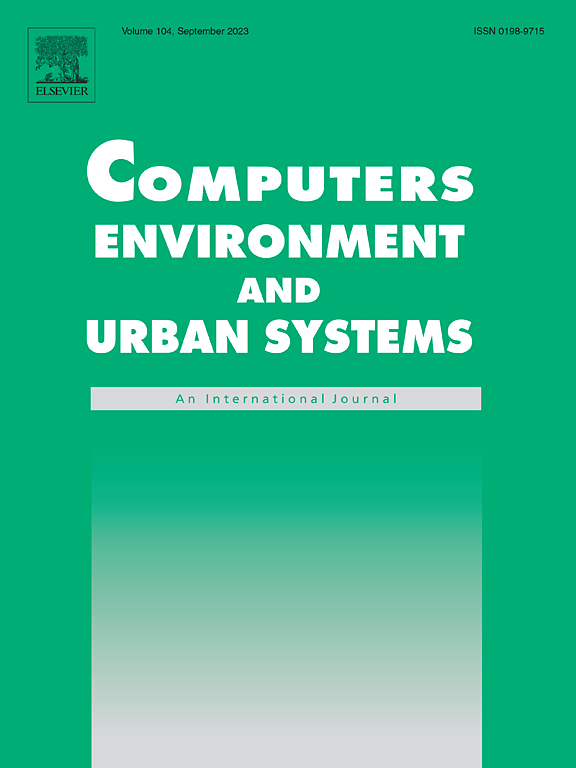Satisfying transport needs with low carbon emissions: Exploring individual, social, and built environmental factors
IF 8.3
1区 地球科学
Q1 ENVIRONMENTAL STUDIES
Computers Environment and Urban Systems
Pub Date : 2024-10-05
DOI:10.1016/j.compenvurbsys.2024.102196
引用次数: 0
Abstract
The article studies the relationships between daily travel greenhouse gas (GHG) emissions and self-rated satisfaction with transport needs. It also investigates the conditions that satisfy one's transport needs at emission levels compatible with internationally agreed reduction targets by 2030 to keep warming below 1.5 degrees. It uses a representative geo-questionnaire survey from Poznan, a functional urban area in Poland (ca 800 thousand inhabitants), with 550 study participants answering questions used in the study. Four built environmental (BE) and accessibility measures are calculated using geospatial methods and used as predictors of low/high emission levels, low/high need satisfaction levels, and their combinations (i.e., social-ecological quadrants), along with socio-demographic characteristics and transport-related resources, competences, and responsibilities. The relationship between transport need satisfaction and GHG emissions is positive but weak and non-linear. In line with previous studies on well-being and energy or carbon footprints, the relationship appears to saturate (i.e., need satisfaction most steeply increasing at low emission levels). The saturation point is at the emission level lower than the 2030 1.5-degree compatible target (∼300 kg CO2/year/person). A sizeable group (∼30 %) satisfies their transport needs at low emission levels (i.e., sufficiency condition). Exploratory spatial data analysis reveals that members of this group cluster in Poznan city center. All BE characteristics significantly and strongly influence the outcome variables, with central, densely populated, and walkable locations increasing the odds of having one's needs met at low emission levels. Retirees comprise about half of the sufficiency group, but there are also many workers. Specific transport needs that negatively impact the ability to meet one's needs at low emission levels, including multiple locations and doing errands on the way from or to work. The results support land use policies that reduce travel distances (i.e., densification, preventing sprawl, promoting walkable street designs) as they support low-carbon access to necessary activities for all social groups. Suburban residential locations, in turn, are associated with low need satisfaction and high emissions. The results also highlight that the ability to meet one's transport needs within the emission threshold is spatially and individually differentiated, with implications for climate policies in the mobility domain.
以低碳排放满足交通需求:探索个人、社会和建筑环境因素
文章研究了每日出行温室气体(GHG)排放量与交通需求自评满意度之间的关系。文章还调查了满足个人交通需求的条件,这些条件的排放水平符合国际商定的到 2030 年将升温控制在 1.5 度以下的减排目标。该研究使用了波兰波兹南一个具有代表性的地理问卷调查,波兹南是波兰的一个城市功能区(约有 80 万居民),共有 550 名研究参与者回答了研究中使用的问题。使用地理空间方法计算了四种建筑环境(BE)和可达性措施,并将其作为低/高排放水平、低/高需求满意度水平及其组合(即社会-生态象限)的预测因子,以及社会人口特征和与交通相关的资源、能力和责任。交通需求满意度与温室气体排放之间的关系是正向的,但较弱且非线性。与以往关于幸福感和能源或碳足迹的研究一样,这种关系似乎趋于饱和(即在低排放水平下,需求满意度陡增)。饱和点位于低于 2030 年 1.5 度兼容目标的排放水平(∼300 千克二氧化碳/年/人)。相当大的群体(∼30%)在低排放水平(即充足条件)下满足其交通需求。探索性空间数据分析显示,该群体成员聚集在波兹南市中心。所有波兹南城市特征都会对结果变量产生重大而强烈的影响,中心、人口稠密和适宜步行的地点会增加在低排放水平下满足个人需求的几率。退休人员约占充足群体的一半,但也有许多工人。具体的交通需求会对在低排放水平下满足个人需求的能力产生负面影响,包括多个地点和在上下班途中跑腿。研究结果支持减少出行距离的土地利用政策(即密集化、防止无计划扩展、推广步行街设计),因为这些政策支持所有社会群体以低碳方式获得必要的活动。而郊区住宅区则与低需求满意度和高排放相关。研究结果还强调,在排放阈值内满足个人交通需求的能力在空间和个体上存在差异,这对交通领域的气候政策具有影响。
本文章由计算机程序翻译,如有差异,请以英文原文为准。
求助全文
约1分钟内获得全文
求助全文
来源期刊

Computers Environment and Urban Systems
Multiple-
CiteScore
13.30
自引率
7.40%
发文量
111
审稿时长
32 days
期刊介绍:
Computers, Environment and Urban Systemsis an interdisciplinary journal publishing cutting-edge and innovative computer-based research on environmental and urban systems, that privileges the geospatial perspective. The journal welcomes original high quality scholarship of a theoretical, applied or technological nature, and provides a stimulating presentation of perspectives, research developments, overviews of important new technologies and uses of major computational, information-based, and visualization innovations. Applied and theoretical contributions demonstrate the scope of computer-based analysis fostering a better understanding of environmental and urban systems, their spatial scope and their dynamics.
 求助内容:
求助内容: 应助结果提醒方式:
应助结果提醒方式:


